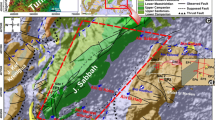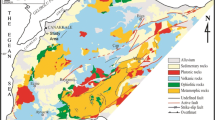Abstract
Sinkholes are natural phenomena caused by the dissolution of limestone rocks due to the infiltration of acidic surface water. Initially, this infiltration creates voids, and then a sudden collapse occurs when the roof structure fails to support the weight load of the overlying deposits. In Algeria, a sinkhole occurred in February 2015 after a severe snowstorm, on an agricultural field near the city of El Ouldja ( South-Eastern Setif). The sinkhole occurred only after the dissolution of a quaternary lacustrine limestone. This dissolution created a karstic cavity, covered by an alluvial deposit. These alluvium deposits progressively pulled down from the base to the top through a sediment removal phenomenon at the deep karstic cavity opening. The sinkhole is circular with 16-m diameter and 16-m deep. This phenomenon represents a risk for local populations living with the fear of a worsening and expansion of the existing cavity or the formation of new sinkholes under the same circumstances. This work aims at identifying high-risk zones in the entire site surrounding the karstic collapse phenomenon through geological analysis of the sinkhole walls as well as two geophysical methods, namely, electrical resistivity tomography (ERT) and electromagnetic induction (EMI). Results revealed the existence of developing superficial karst cavities, in the NNW and SSE part, beneath the Quaternary alluvium of the study area, bordered by a fracture network. Such structures are a natural risk that needs to be considered not only for agricultural land management, but also for rural construction.









Similar content being viewed by others
References
Benabbas C (2006) Évolution Mio-Plio-Quaternaire des bassins continentaux de l’Algérie nord orientale: apport de la photogéologie et analyse morpho structurale. Thèse de doctorat, Univ. Mentouri Constantine. Algerie
Cardarelli E, Cercato M, De Donno G (2014) Characterization of an earth-filled dam through the combined use of electrical resistivity tomography, P-and SH-wave seismic tomography and surface wave data. J Appl Geophys 106(7):87–95
Chambers JE, Penn S, Wilkinson PB, Weller AL, Evans HM, Kuras O, Aumônier J, Ogilvy RD (2007) The development of electrical resistivity tomography (ERT) for sand and gravel ResourceVisualisation Survey Design and Data Processing Criteria. British Geological Survey Commissioned Report, CR/07/173. 94 pp
Dahlin T (2001) The development of DC resistivity imaging techniques. Comput Geosci 27(9):1019–1029
Degroot-Hedlin C, Constable S (1990) Occam’s inversion to generate smooth, two-dimensional models formmagnetotelluric data. Geophysics 55(12):1613–1624
Dey A, Morrison HF (1979) Resistivity modelling for arbitrary shaped three-dimensional structures. Geophysics 44(4):753–780
Farooq M, Park S, Song YS, Kim JH, Tariq M, Abraham AA (2012) Subsurface cavity detection in a Karst environment using electrical resistivity: a case study from yongweol-ri, South Korea. Earth Sci Res J 16(1):75–82
Friedel S (2003) Resolution, stability and efficiency of resistivity tomography estimated from a generalized inverse approach. Geophys J Int 153(2):305–316
Griffiths DH, Barker RD (1993) The use of multi-electrodes resistivity imaging in gravel prospecting. J Appl Geophys 49(4):245–254
Griffiths DH, Turnbull J (1985) A multielectrode array for resistivity surveying. First Break 7(3):16–20
Hermosilla RG (2012) The Guatemala City sinkhole collapses. Carbonates Evaporites 27(2):103–107
Kaufmann G (2014) Geophysical mapping of solution and collapse sinkholes. J Appl Geophys 111:271–288
Keller G (1988) Rock and mineral properties. In: Nabighian MN, Corbett JD (eds) Electromagnetic methods in applied geophysics theory, 1: soc. exploration geophysics, pp 13–51
Keller G, Frischknecht F (1966) Electrical methods in geophysical prospecting. Pergamon Press, New York. 517p
Khaldaoui F, Djeddi M, Abtout A, Baker HA (2011) Geophysical investigation to characterize geological risks: detection zones of dissolution in karst areas, Algeria. First International Conference on Engineering Geophysics, Al Ain, United Arab Emirates.
Kim JH, Yi MJ, Hwang SH, Song Y, Cho SJ, Synn JH (2007) Integrated geophysical surveys for the safety evaluation of a ground subsidence zone in a small city. J Geophys Eng 4(3):332–347
Kirsten HAD, Heath GJ, Venter IS, Oosthuizen AC (2014) The issue of personal safety on dolomite: a probability-based evaluation with respect to two and three-story residential houses. J South Afr Inst Civil Eng 56(2):54–64
Klimchouk A (2005) Subsidence hazards in different types of karst: evolutionary and speleogenetic approach. Environ Geol 48(3):287–295
Loke MH (1997) Rapid 2D resistivity inversion using the least-squares method. RES2- DINV Program manual, Penang, Malaysia
Loke MH, Barker RD (1995) Least-squares deconvolution of apparent resistivity. Geophysics 60(6):1682–1690
Loke MH, Barker RD (1996a) Rapid least square inversion of apparent resistivity pseudosections by a quasi- Newton method. Geophys Prospect 44(1):131–152
Loke MH, Barker RD (1996b) Pratical techniques for 3D resistivity surveys and data inversion. Geophys Prospect 44(3):499–523
Loke MH, Acworth I, Dahlin T (2003) A comparison of smooth and blocky inversion methods in 2D electricalimaging surveys. Explor Geophys 34(3):182–187
Maurer H, Boerner DE, Curtis A (2000) Design strategies for electromagnetic geophysical surveys. Inverse Problems 16(5):1097–1117
McNeill JD (1980a) Electromagnetic terrain conductivity measurement at low induction numbers. Technical Notes TN6. Geonics Limited (Editor), Ontario
McNeill JD (1980b) Electrical conductivity of soils and rocks. Technical Note TN-5. Geonics Ltd., Mississauga, p 22
Parasnis DS (1986) Principles of applied geophysics, Fourth edn. Chapman and Hall. 429p
Parise M, De Waele J, Gutiérrez F (2009) Current perspectives on the environmental impacts and hazards in karst. Environ Geol 58(2):235–237
Robert T, Dassargues A, Brouyère S, Kaufmann O, Hallet V, Nguyen F (2009) Using electrical resistivity tomography and self-potential methods for wells implementations in fractured limestones. Near Surface. 15thEAGE European Meeting of Environmental and Engineering Geophysics A32
Schoor MV (2002) Detection of sinkholes using 2D electrical resistivity imaging. J Appl Geophys 50(4):393–399
Silvester PP, Ferrari RI (1990) Finite elements for electrical engineers, second edn. Cambridge University Press, Cambridge. 514p
Szalai S, Szarka L, Prácser E, Bosch F, Müller I, Turberg P (2002) Geoelectric mapping of near-surface karstic fractures by using null-arrays. Geophysics 67(6):1769–1778
Tharp TM (1997) Mechanics of formation of cover-collapse sinkhole. In: Beck J, Stephenson J (eds) The Eng. Geol. & Hydrogeol. of Karst Terranes, pp 29–36
Ward SH (1990) Resistivity and induced polarization methods. In: Geotechnical and environmental geophysics. Society of Exploration Geophysicists, vol 1, pp 147–190
Won IJ, Huang H (2004) Magnetometers and electro-magnetomenters. Lead Edge 23(5):448–451
Youssef AM, El-Kaliouby HM, Zabramawi YA (2012) Sinkhole detection using electrical resistivity tomography in Saudi Arabia. J Geophys Eng 9(6):655–663
Zhu J, Currens JC, Dinger JS (2011) Challenges of using electrical resistivity method to locate karst conduits – afield case in the Inner Bluegrass Region, Kentucky. J Appl Geophys 75(3):523–530
Acknowledgments
This work is part of a research project CNEPRU/G00220130074/ supported by the Algerian Ministry of Higher Education and Scientific Research. The survey of the present work was carried out in April 2015. The authors would like to thank the local authorities of the Municipality of El Ouldja for their support in this study.
Author information
Authors and Affiliations
Corresponding author
Additional information
Responsible Editor: Narasimman Sundararajan
Rights and permissions
About this article
Cite this article
Fatma, K., Yacine, D., Haydar, B. et al. Use of electrical Resistivity tomography (ERT) and electromagnetic induction (EMI) methods to Characterize Karst Hazards in north-eastern of Algeria. Arab J Geosci 13, 1204 (2020). https://doi.org/10.1007/s12517-020-06206-9
Received:
Accepted:
Published:
DOI: https://doi.org/10.1007/s12517-020-06206-9




